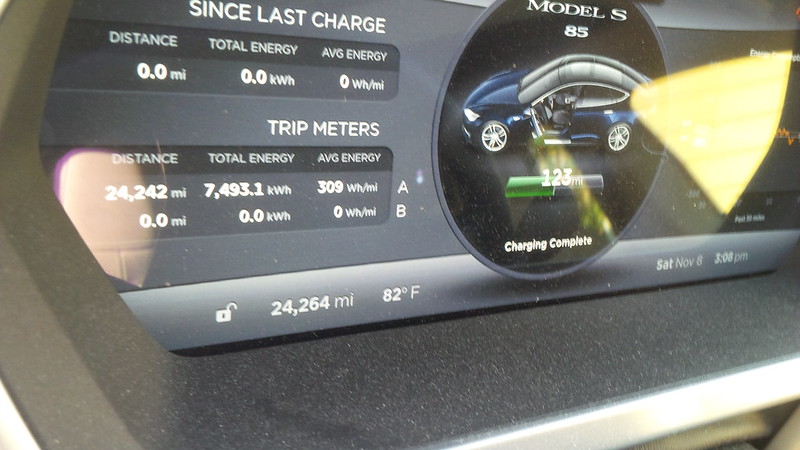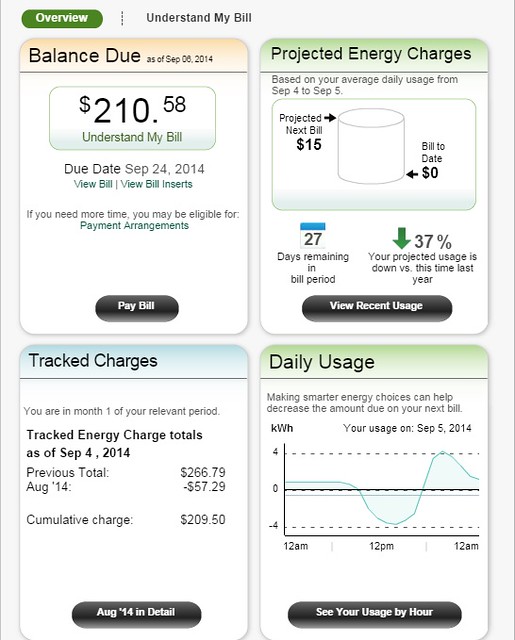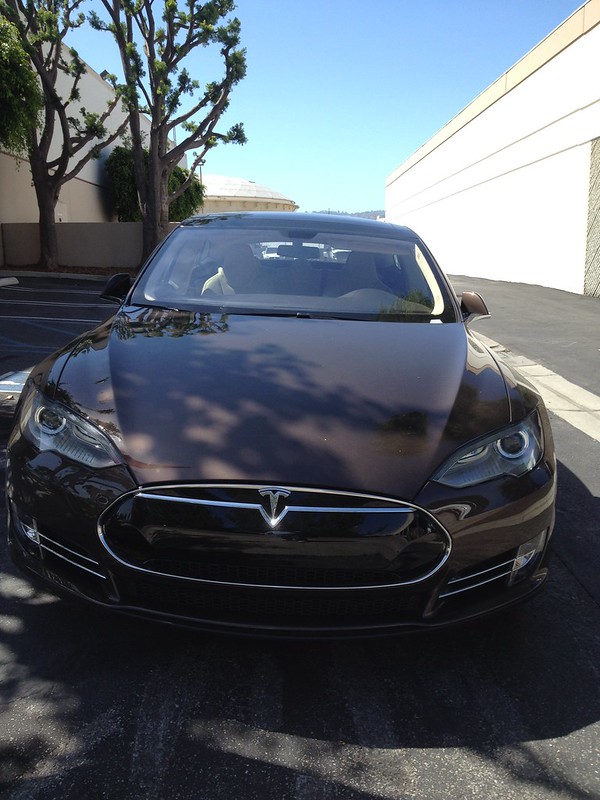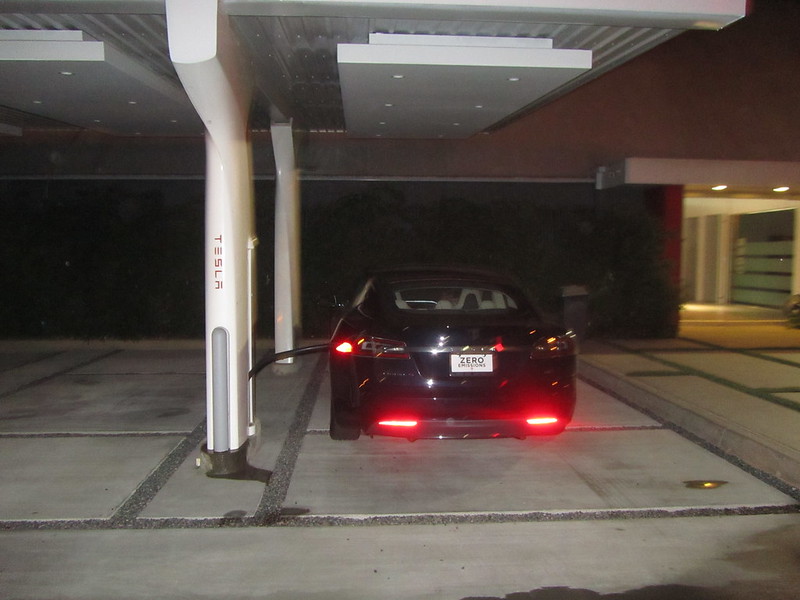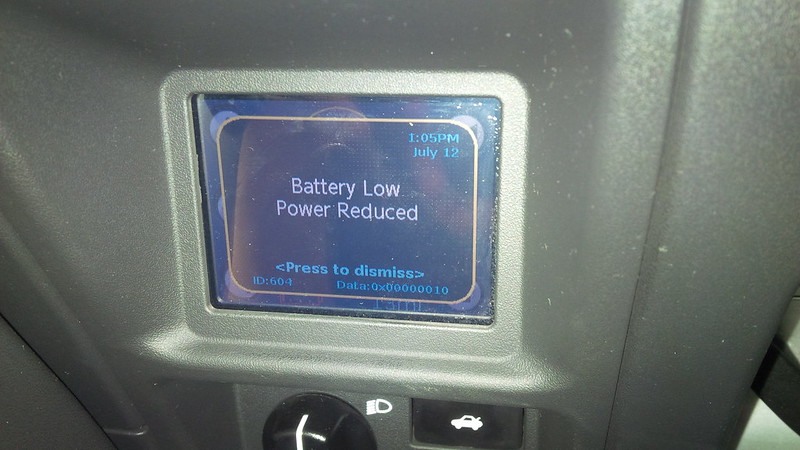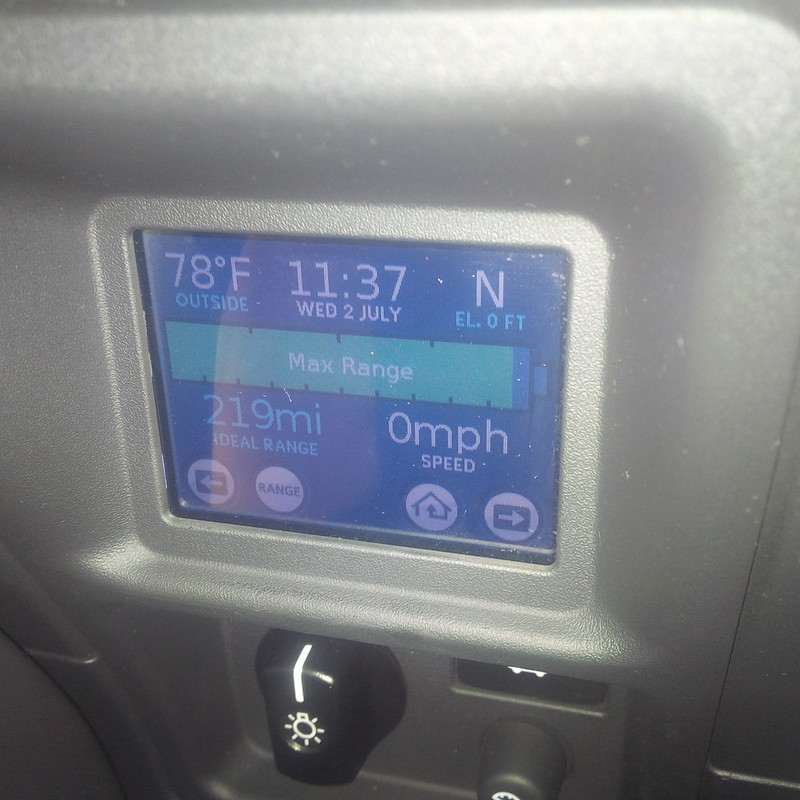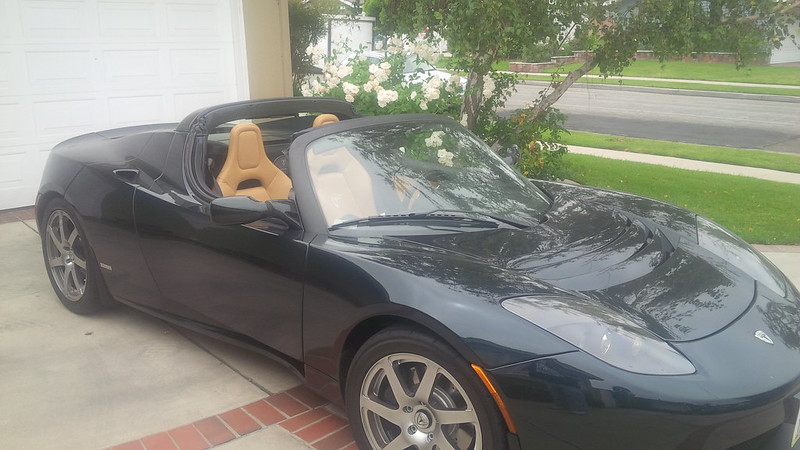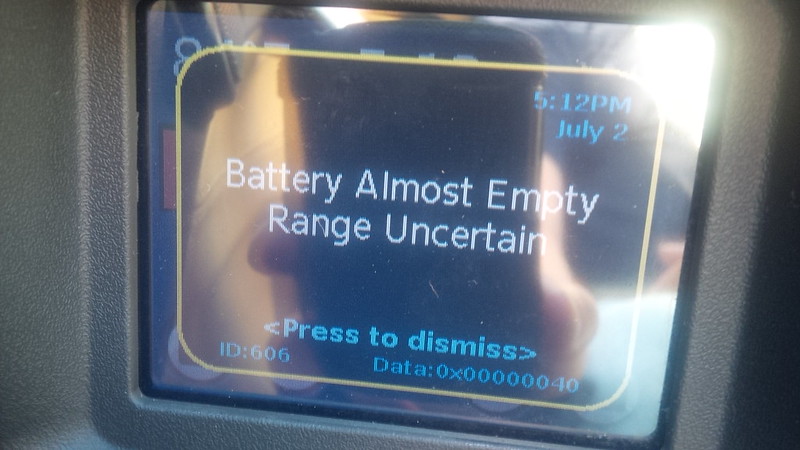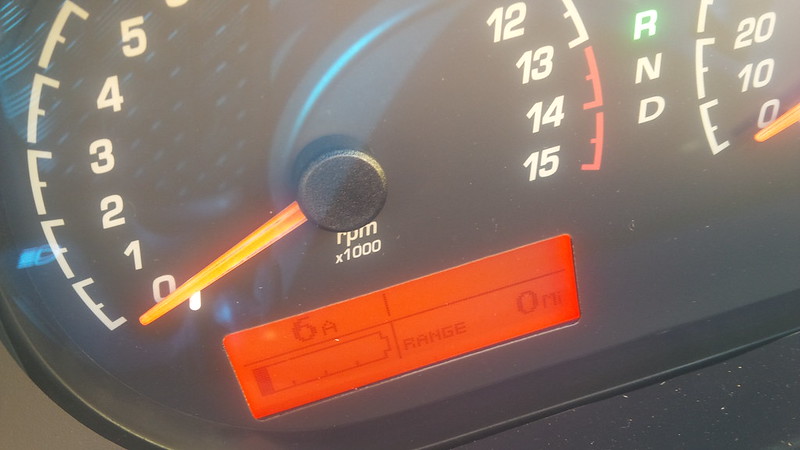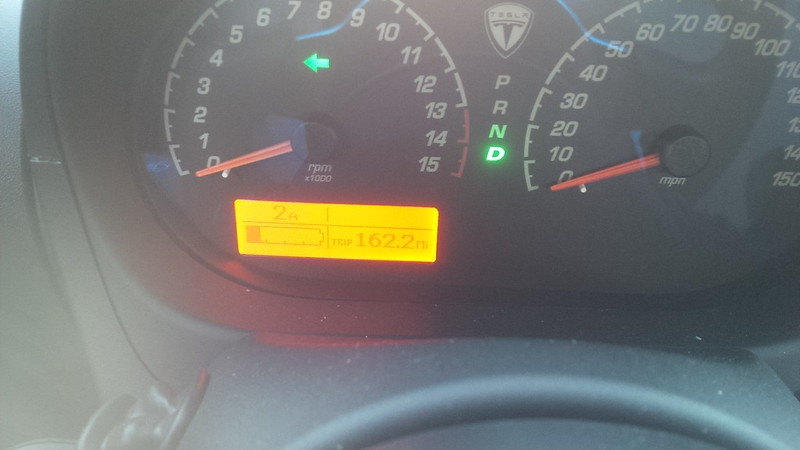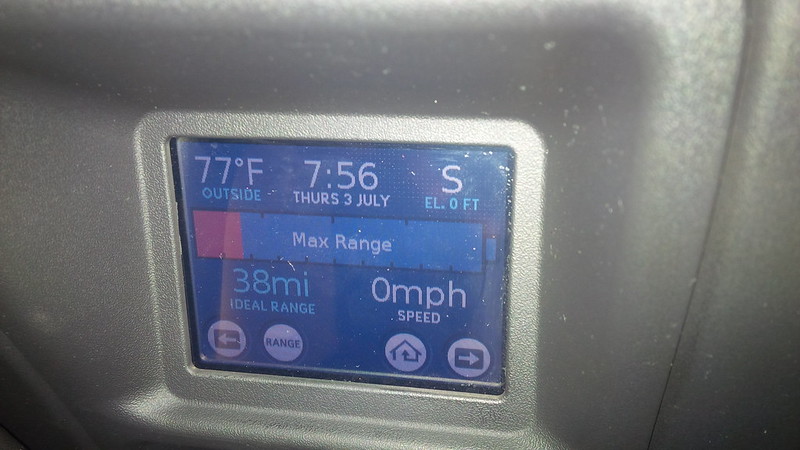|
Category: Tesla Roadster
One Year Model S Anniversary
A year and about thirty minutes ago we picked up our Model S.
In that time, we’ve amassed 24,264 miles on the Model S. Less than we did with the Active E, but considering we’ve had our Roadster for about 14.25 months, we also got about 11,379 miles on the Roadster, that’s really a greater total of EV miles than we did after our first Active E year.
[One thing I noticed after updating with a picture of the mileage is my actual driven miles (Trip A is 24,242… Funny)]
I’ll sit and think about it later. But for now!
Cheers!
(If you’re interested in reliving our Model S weekend… It starts here. Or when we actually picked up the Model S.)
Battery Degradation and Tesla’s “Warranty”
[The original version of this post was written as a response on SpeakEV.com forum a few days ago.]
All EV batteries degrade. The important thing is to warrant what is acceptable degradation and what is not. Lacking the guidelines sucks, for lack of a better word, but it isn’t fatal. It’s just part of the equation.
We own our two Teslas and I am disturbed by Kevin Sharpe’s Experience, but the published guidelines did say 30% in five years… All this means is caveat emptor.
Our Roadster was already five years old when we bought it, so, I would love to know what I get with the CPO Warranty or what we would get with purchase of the 400 mile upgrade batteries. How long will the car run up to 400 miles.
On Twitter, Nikki Gordon-Bloomfield (@aminorjourney), has postulated that battery packs are the consumable portion of EVs.
An electric car battery is a consumable item: discuss.
— N. Gordon-Bloomfield (@aminorjourney) September 9, 2014
Like it or not, she has a valid, and yet expensive point. However, unlike gasoline/petrol we don’t have to replace every time we charge, only as long as the batteries are useful for us. In which case, it’s eventually time to change.
Tesla’s Roadster warranty had defined that in a binary situation, so, if one were to make the case to swap it out under Tesla’s warranty, it can’t be done based on degradation, it is because of a full battery/system failure. This sucks, unfortunately that is what was warranted.
Now the valid question for Model S owners (and guess what, I’m one of those too) is what about our battery packs? Well.. We’ll need to see if degradation is covered.
[This is where new information, or should I say OLD information was posted on the Model S Warranty (including the current “unlimited” Model S warranty) also specifically excludes battery degradation. As was pointed out on both TeslaMotorsClub.com and SpeakEV.com forums, see page 35 and 36 (pages marked 33 and 34 due to other unumbered pages) of this PDF.
The particular language excerpted from the PDF link above:
“The Battery, like all lithium-ion batteries, will experience gradual energy or power loss with time and
use. Loss of Battery energy or power over time or due to or resulting from Battery usage, is NOT
covered under this Battery Limited Warranty. See your owner documentation for important
information on how to maximize the life and capacity of the Battery.”]
Otherwise, prepare to save for a replacement battery pack in the future. I have always recommended (often in the early years of my blog and in forums) that new EV owners put aside half of what their “fuel” savings aside for the future need to buy a replacement pack IF they do as I do with most of my cars (and that’s keep them for a LONG while) (my hybrid garage has a 2001 BMW X5, my non-green, I have to get to the mountains for Fresh Snow car.)
Guess what, that advice still holds. I’ve lost five miles of rated range from 265 max charge to 260 max charge. Ideal miles lost 3 miles. And I’m less than a year AND over 20,000 miles. However, it must be noted that Tesla delivered the car with greater than 300 miles of ideal miles and I’m just around 299-300 miles ideal now. Yes, it’s hotter in California than the UK and we do have active thermal management, but it’s still the case that degradation happens. I still made it to Barstow, then Vegas on SCs. The car is still awesome, the Roadster is still fun, and Tesla is not perfect. I never thought they were (if BMW i didn’t piss me off as much, I might still have picked up the i3 I ordered.)
[end of almost original forum post.]
After a day of mulling over the lack of battery degradation and comparing the Nissan Warranty, BMW’s match of said warranty and the fact that Tesla’s two competitors include battery degradation, I believe that it is time to call out Tesla and tell them that they need to include battery degradation into the equation. Spell it out. If it is the same specifics as the 2006 Roadster blog post that says 30% after five years, then that’s what it is. It’s not very impressive and I would ask that CPO Roadsters be provided with a modification to this, but that’s at least something. Additionally, AFTER providing such guidance, give us a price on replacement batteries. Nissan gave a $5,500 rate for their cars, why can’t Tesla do it now? With the pending Gigafactory, surely the economics only gets to improve.
C’mon Tesla, be awesome again!
So, we got our bill for the second year of Solar usage from SCE.
It’s been two years since our PTO was approved, and, as opposed to last year, when all we had was the Active E, we pretty much used at LEAST two EVs, if not three EVs over the past year.
In our first year of Solar use, we had a credit. Which, as we found out, we could not claim. Because, it turns out, SCE’s though we’re credited for the production at a $ rate, with net metering, customers are paid out on OVERPRODUCTION and not on the CREDITS earned. What this means is the system has to produce greater kWh of energy than consumed by the end user. If this is the case, the customer is PAID OUT the power times the wholesale rate of production.
Last year, we had a lot of credit as we primarily used energy overnight (at Super Off-Peak) and produced power during the day (the Peak rate). However, we actually used more kWh of energy than we produced. So, even though we had a credit last year, we were not paid out.
This year. We got our Tesla Roadster in the beginning of September, so, when our second year of service started, we were pretty much using TWO EVs. Then we got the Model S, and we were using three EVs during that time until the Active E was turned back in at the end of February. Regardless, the Model S and Roadster consumed energy at a greater rate than the Active E, so we did use more energy than we produced AND totaled a higher amount than we had been credited. Thus, the bill. Even so, at approximately $20 a month for all the driving that we do, and the home power usage. It’s still a win!
Interested in going solar? Get a quote from my solar vendor – Real Goods Solar.
Roadster Annual Service… interrupted…
So, the Roadster went into its first Annual Service on September 2nd. I made sure to communicate my ongoing concerns about the drop in ideal range in standard mode from 186 a year ago (when we picked up the car) to the low of 171 miles before I started doing the conditioning tests (and a high of 175-176 that I’ve had since the beginning of July.)
Today, when I picked up the car (not quite done with some of the work as we’re waiting for parts from Fremont) I was pleasantly surprised to see that the standard charge is now at 183 miles. After one year, a degradation of 3 miles (in about 10,000 miles and one year of CPO use is a LOT more acceptable than the 15 miles that had caused me to raise the alarm last month.)
In the USA, Tesla Roadster Annual Service is $600. So, what do you get for the $600…
1) Fix things… In our case, we had a fracture in an AC line. Waiting on the part, so we’ll have to bring the car back when they get the part. (which is why the service was interrupted.)
2) Replaced a few more things:
Wiper Blade (2001366) 1
BAFFLE, INLET, PEM, DSTAR 1.5 (6002570) 1
3) Tire pressure (then again they ALWAYS do this, it’s mandated in California
4) Got a Model S Standard 60 loaner.
5) Some parts were replaced after inspections –
Concern: Part missing following service
Pay Type: Goodwill
Corrections: Power Electronics Module (PEM) – Roadster 1.5
Power Electronics Module (PEM) – Roadster 1.5
Part Quantity
NUT,HEX,M6,ST STL,NYLOC (2000821) 4
COVER, SRS DISCONNECT, PEM
(6000779)
1
WSHR,M6 X 12 X 1.4,ST STL,GENERIC
(2003995)
4
ASSY,BRACKET,TPMS,RIGHT (6000924) 1
Parts Replaced or Added
Corrections: Soft Top Assembly
Soft Top Assembly
Part Quantity
SCR, CABLE TO SOFT TOP (6002461) 4
CABLE, TENSIONING SOFT TOP (6002465) 2
6) We complained of some “weird” noises…
Concern: Customer states: Vehicle noisy while driving – noise from rear
Pay Type: Goodwill
Corrections: Upright – Suspension – Rear – LH
removed and replaced upper control arm- left rear bushings
Part Quantity
BUSH-REAR SUSPENSION LONG
+INTERLEAF (2001482)
2
Parts Replaced or Added
7) The rear tires are worn… After 10,000 miles, looks like it’s time to replace the rear tires… Have to do it when we get back. Though I told them to replace the tires, there is still some wear left and we’ll do it when the part that we’re waiting for is ready.
8) Also waiting for a replacement driver side door sill that has a crack. So that’s something that we need to wait for as well.
9) Pulling logs seemed to have gotten stuck. So, the tech freed it up so that I can pull logs again.
In all, I’m very happy that after the battery bleed test and whatever else the technician did, we’re back over 180 miles for a full standard charge. I count that as a win.
It’s great to get an explanation on the delays in Roadster parts. In my case, some parts were readily available and fixed those things, but others are delayed because, per the Service Advisor, the Warehouse that houses a majority of Roadster parts is being moved. So, we’re now waiting for the move to complete so they can get the parts to us. Hopefully this means next week.
So, all the parts we’re waiting for are covered by the bumper to bumper CPO warranty, with the exception of the tires. They’re not the cheapest in the world, but along the same lines as other “high performance” tires.
What else will Tesla give you? Free Wi-Fi of course.
I spend a lot of time at Tesla facilities… Whether it’s a supercharger, a Tesla Store, or Tesla Service, I tend to like to be at Tesla facilities.
Yes, I’m obsessed. Either way, what else do you get for free at Tesla, well, their guest Wi-Fi is free and the password is the super secure “abcd123456”.
So, if you find yourself supercharging at Hawthorne, CA or at a Tesla Service Center, just remember to connect to the “Tesla Guest” or “Tesla Motors Guest” network and use that super-secure password.
Now, remember, it’s a shared wi-fi network, so be warned, be careful, and be safe. Use some sort of protection when connecting.
Here’s my Model S at a late night stop on the way home from Hawthorne on our first Tesla Weekend… using the free wi-fi at Hawthorne Design Center/Supercharger.
First Tesla Roadster range test in standard mode, July 9-July 12, 2014.
I was advised by the Service Center to have my wife do her normal drive and not plug the car in until about ten miles.
So, over the course of several days (from July 9th to July 12th) we did just that. Thank goodness we have OVMS, since I use that to let me know when the SOC has dropped to around 25% and have a good gauge of how much more driving we can do. I used to have it set at 50%, but decided to lower the threshhold since we’re not planning on plugging it in until it’s closer to ten (ideal) miles in standard driving mode. This was just a matter of sending a text message “FEATURE 9 25” to OVMS to configure the SMS Alert when the state of charge drops to 25%. OVMS will send a text back saying “Feature has been set.”
I created a log file to track what the miles would be overnight to see what sort of vampire loss the Roadster had in comparison to the Model S and was pleasantly surprised to see that the car lost 1% over the course of almost 1.64 days from the time I parked the car at home.
| Date | Park at Home | Leave Home | SOC | CAC |
| July 9, 2014 at 6:00 PM | 142 | 81% | 145.73 | |
| July 11, 2014 at 9:23 AM | 142 | 80% | 145.74 | |
| July 11, 2014 at 9:10 PM | 76 | 44% | 145.66 | |
| July 12, 2014 at 11:41 AM | 76 | 44% | 145.66 | |
| July 12, 2014 at 1:07 PM | 13 | 7% | 145.66 | |
| July 13, 2014 at 12:00 AM | 234V/40A | 325 Minutes | 5.416666667 | hours |
| July 13, 2014 at 6:30 AM | 175 | 97% | 145.66 |
As you can see from the spreadsheet above, I actually had the car at the Service Center and back home the first day, July 9th. I parked the car around 6pm with 142 Ideal Miles of Range left and the car sat unplugged at home for a little over a day and a half, before my wife took the car out on Friday. Per OVMS readings, it had lost about 1% SOC (and no ideal miles). She drove the car for about 66 ideal miles (closer to 60 actual miles) and got home on Friday night with 76 ideal miles (and 44% SOC) of range left in the car.
Overnight, the car did not lose either ideal miles or % SOC and we drove off. Around 20 ideal miles left (and on the way home) on Saturday, we got the following error:
Though it mentions that power is limited, I was on the freeway, and the power seemed to be fine.
We finally plugged in with 13 ideal miles of range last night. Interesting, the rated range was down to 12 miles.
So, after 158.4 miles for the past few days, we recharged at standard mode.
7% SOC in Standard mode left, and the CAC values dropped to 145.66. We recharged overnight and ended up with 175 ideal miles at 6:30 AM. Basically, I checked the status when I woke up, and wrote it down. Because by the time I rolled out earlier today I already lost a mile of range. We will have to do this again for a few more times this next month, but that didn’t seem to have helped any. It’s going to be a long month.
Update on Tesla Roadster CAC and Ideal Miles testing
So, I started a new thread at teslamotorsclub.com on this issue which has helped me a lot on figuring out what I can and can’t see on the vehicle.
So, I’ve followed some of the advice and used VMSParser and the Tesla Graphical Log Parser (Tesla GLoP) to copy the logs down from the Roadster and see what values are generated from it. Aside from OVMS, my favorite telematics product, providing me with realtime statistics on the vehicle. I love the nearly six years of user experience that are the long-time Roadster owners/community. They’ve created tools such as the two log parsing programs to extract knowledge about the vehicle.
I posted a sample of the last month:
timestamp, brickahmin, brickahave, bricknumber
6/9/2014 14:29:11 143.26 148.67 74
6/10/2014 14:29:09 143.14 148.62 74
6/11/2014 14:29:11 142.8 148.39 74
6/12/2014 14:29:12 142.63 148.05 74
6/13/2014 14:29:11 142.4 147.7 74
6/14/2014 14:29:11 142.63 147.88 74
6/15/2014 14:29:11 142.69 147.88 74
6/16/2014 14:29:11 142.97 148.16 74
6/17/2014 14:29:12 142.92 148.27 74
6/18/2014 14:29:11 143.2 148.62 74
6/19/2014 14:29:12 143.03 148.22 74
6/20/2014 14:29:11 142.8 148.1 74
6/21/2014 14:29:11 142.46 147.76 74
6/22/2014 14:29:12 142.63 147.88 74
6/23/2014 14:29:12 142.8 147.99 74
6/24/2014 14:29:13 142.75 148.1 74
6/25/2014 14:29:13 142.52 147.76 74
6/26/2014 14:29:13 142.46 147.42 74
6/27/2014 14:29:13 142.57 147.19 74
6/28/2014 17:09:38 143.03 147.59 74
6/29/2014 17:09:38 142.8 147.08 54
6/30/2014 17:09:38 143.2 147.36 54
7/1/2014 17:09:36 143.37 147.65 54
7/2/2014 17:20:32 144.17 148.39 54
7/3/2014 17:20:32 145.03 148.67 54
7/4/2014 17:20:31 145.03 148.67 54
7/5/2014 17:20:31 145.14 148.79 54
7/6/2014 17:20:33 145.14 148.79 54
7/7/2014 17:20:33 145.31 148.9 54
7/8/2014 17:20:34 145.65 149.3 54
And was advised that if the last value does not change for a while that it could be the issue (a bad brick that is dragging the whole sheet down.). The fact that the brick has changed throughout the month, shows that I probably don’t have a single deficient brick. In the thread, Kevin Sharpe showed his Roadster log values and shows what a bad brick problem looks like.
Aside from the self-help stuff, one of the advantages of purchasing a Roadster under the Certified Pre-Owned program, is the access to the SC at no additional charge (for warranty issues). I was already scheduled to bring the car into service for an issue with fogging in the headlights, so I had them look into the loss of Ideal Miles and CAC values.
So, the Service Technician/Shop Foreman for the Southern California Service Center that I took my car too have provided the following plan of attack after they’ve looked at the car (and did the bleed test, updated the firmware (to support the >70A bug)) considering that our annual maintenance for the Roadster is upcoming.
Since my better half’s daily drive is approximately 60 miles a day, he suggested that we drive the vehicle in Standard Mode and run the car down to about 10 Ideal miles for at least three times over the next month and charge back up in Standard Mode. On those evenings that the car has NOT been driven down to the 10 Ideal miles, we were advised to park it, but do not plug it in overnight. I’d like to track the vampire loss for the vehicle as we do this.
During an extended period of non-use, the tech suggested that we plug in the Roadster using storage mode during that time.
After the month, and possibly during the annual maintenance, they’ll look at what happened to the pack after these tests.
I did see some improvement in minimum CAC values over the past week since I did my test on July 2nd and July 3rd… So, we’ll see. Will report here (as well as on teslamotorsclub.com).
First Daily “Standard” charge after the weekend’s Range charge test
No pictures, ’cause I had to head to work quickly…
Step two of the Range Test Days and Tesla Roadster pack rebalancing that I was doing was to get to my first daily “standard” charge to see if it made a difference.
Following Michael Thwaite’s suggestion to maintain the charge (and not drain too low) we plugged in the Roadster on Saturday night with about 102 Ideal Miles on Storage mode.
On Sunday, drove the car out for some further errands, etc. and ended up home with 21% SOC/37 Ideal Miles/34 Rated Miles left (thanks to OVMS again).
This time, I plugged it in and performed a STANDARD charge starting at midnight… (a few hours earlier than I normally set the car to charge. To maximize the amount of 40A/240V charging that I will do at super-off-peak EV rates.
When I rolled out at 9am, the car had 174 Ideal Miles on it and the CAC values were at 145.44. It was a slight improvement to the 171 Ideal Miles that I observed last week, but definitely nothing to write home about.
I guess we’ll have to see if we can change my better half’s behavior and see if she can plug it in every other day so that we can drain the battery down 120 miles in two days of driving vs. the 60 miles a day that she normally charges under to see if that will do something to improve the CAC values and ideal miles after a full charge.
I cross posted questions on these tests to teslamotors.com, so wanted to put the CAC values here –
Values from October 2013, when I first started to use OVMS.
Standard – Charging Done SOC: 96% Ideal Range: 183 mi Est. Range: 173 mi ODO: 3,578.8 mi CAC: 154.38
Values from today overnight charged in Standard mode and 174 miles (the CAC value is the same from the evening before it started to charge.) (unfortunately after my wife drove about 30 miles)
Not charging SOC: 82% Ideal Range: 147 mi Est. Range: 144 mi ODO: 10,901.2 mi CAC: 145.44.
Rebalancing the Telsa Roadster battery pack
One of the things that one should be concerned with when buying a used Electric Vehicle is battery health. We were confident with purchasing our 2008 Signature 100 Tesla Roadster from Tesla Motors because they warranted the vehicle for 37 months or 37,000 miles, whichever comes first. Additionally, the vehicle we purchased only had 2,220 miles when we bought it, so it would seem that the previous owner took good care of the vehicle. When we first picked up the car, its daily charge was around 185-186 miles. At the actual day that we picked it up, we range charged it for the first time the numbers were closer to 240 miles (don’t remember exactly what it was)
However, since September 2013, the car’s daily range has gone down to around 172 ideal miles. That’s about a 7.5% drop in ideal miles since we acquired the vehicle. Understanding that a 2008 vehicle isn’t that new and I should expect some loss, the question is how much loss is acceptable for something that has a warranty. Is the loss even real? There have been reports to indicate that a Tesla Roadster’s algorithm for range calculation isn’t very good.
Apparently an approximately 60 mile daily roundtrip is too short and could also lead to an “artificial” loss of range. So, I’m unsure whether there is a real loss or whether it is unreal.
To combat this challenge, I’ve looked at some sources to see what I can do to rebalance the pack. The first method I tried to do was several months ago at teslamotorsclub.com. Having followed the process gained a few miles temporarily, but the decline still occurred. So, this week, I figured to go ahead and see what else I can do.
I spoke with some of the Tesla Service Advisors and I was told by one of the advisors who uses a Roadster to try something different. Range charge and drain the battery down to at least 30% SOC and then do another range charge. Then repeat. So, the pictures will be what I’ve done on July 2nd and July 3rd.
So, my first range charge was done from the evening of July 1st to July 2nd. Started at 219 miles of range and decided to do a long drive to the desert.
Here is the car with the top-down. After all, it’s the summer in Southern California.
So, after 165.5 miles of driving, I encountered the following error:
Now, I’m not sure if the second half of my drive was in Range Mode or Standard mode, but I did drain the battery, so I miscalculated and ended up back home at 10% SOC.
Range was estimated at zero, because it couldn’t calculate things, luckily I use OVMS, and that told me that I had 10% SOC left. So, I wasn’t nervous.
So, after the first day, I charged the car all the way back in Range Mode and got the following the next day:
That’s 222 ideal miles and 201 rated miles. Ideal miles are based on the ideal 55mph in flat terrain vs what I actually drove the previous drive. Granted, another reason I had really low range was because I was “inspired” to drive a little faster than the speed limit for quite some distance.
So, in day two, I tried to drive with a lot more restraint, and after 162.2 miles of driving, I decided to go home.
Using OVMS, I could see that I still had 16% SOC left and a rating of 38 ideal miles left.
So, did that do it? Well, day two ended, and this morning, I saw that the car charged at 222 ideal miles again. The CAC values was higher than before the test, but not much more. So, I guess we’ll have to see what happens after the Fourth of July Holiday weekend.
To see if the theory that charging the car less will help, the next trick is to drive the car down before plugging it in rather than plugging the car in on a daily basis. This would also mean we’ll have to pay attention to any vampire drain and plug in the vehicle as soon as it needs it. Fingers crossed, hope that works. In the meantime, Tesla’s downloaded the logs, and if they see something there, then we get it fixed or validated. The Service Center guys were talking a bleed test, so, who knows. Either way, 172 miles daily range is still almost double what we got from the Active E.
And lastly, it does help to drive conservatively to get closer to ideal range than driving with a heavy foot… But it’s a Tesla Roadster for crying out loud, it just screams to be driven with a lot of speed, especially when the top is down in beautiful weather.
